The Economics and Statistics Division maintains archives of previous publications for accountability purposes, but makes no updates to keep these documents current with the latest data revisions from Statistics Canada. As a result, information in older documents may not be accurate. Please exercise caution when referring to older documents. For the latest information and historical data, please contact the individual listed to the right.
<--- Return to Archive
For additional information relating to this article, please contact:
February 28, 2017CAPITAL AND REPAIR EXPENDITURES SURVEY, 2016 (PRELIMINARY) AND 2017 (INTENTIONS) Statistics Canada has released the results of its annual survey of capital expenditures for non-residential construction and machinery and equipment. The preliminary estimate for 2016 and intentions for 2017 is based upon a sample survey of 25,000 private and public organizations conducted over September 2016 to January 2017.
Capital expenditures include non-residential capital construction and machinery and equipment spending. In 2016, capital expenditures increased 11.4 per cent to $3.862 billion in Nova Scotia. This was the second annual increase, but remains below peak year of 2010 when non-residential tangible assets spending was $4.4 billion. Growth in 2016 occurred with gains in private construction (+30.4%) and private machinery and equipment (+9.3%) but declines public capital expenditures (-3.6%).
Capital expenditure intentions for 2017 are down 0.6 per cent or by $25 million to $3.837 billion. Private construction (-3.5%, -$47 million) and machinery and equipment (-6.3%, -$89 million) expenditures are expected to be down while public capital expenditures are expected to increase 10.2% (+$110.8 million) on higher construction expenses.
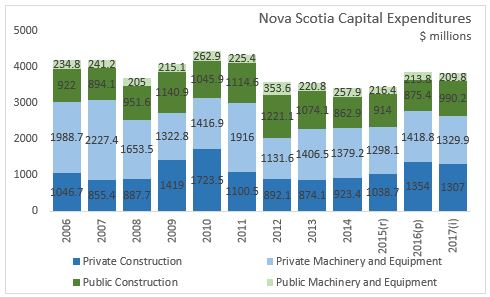
Repair expenditures increased 6.9 per cent in 2015, the second consecutive year of growth. Repair expenditures increased on construction (+12.4%) and on machinery and equipment (+4.1%) and for both private (+1.0%) and public (+25.2%) assets.
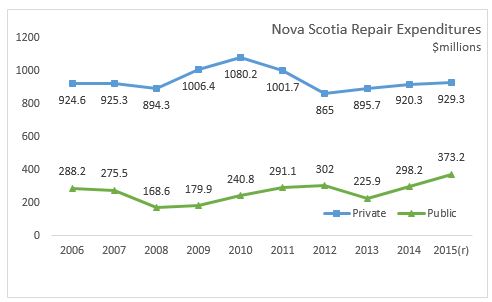
On an industry basis, the $395 million increase in capital expenditures occurring in 2016 was mainly due to increases in utilities (+$146 million), transportation and warehousing (+$131 million), educational services (+$105 million). Increases also occurred with public administration (+$67 million), arts, entertainment and recreation (+$38 million) and health care and social assistance (+$32 million) and there were smaller gains in other sectors. Capital expenditures in the manufacturing sector had a decline of $134 million in 2016.
For 2017, total capital expenditures are expected to decline by 0.6 per cent or $25million. The largest decline is in the transportation and warehousing sector ($166 million) and mining, quarrying, and oil and gas extraction (-$47 million). There are declines of less than $15 million in agriculture, forestry, fishing and hunting, manufacturing, retail trade, finance and insurance, information and cultural, health care and social assistance, arts, entertainment and recreation, and other services (except public administration). The largest increases for 2017 will be further increases in spending that are expected in utilities (+$55 million), educational services (+$120 million) and public administration (+$48 million).

Canada is expected to see an increase of $1.8 billion in capital expenditures in 2017 following two years of annual declines. Capital spending by public sector organization is expected to increase 4.9 per cent following a gain of 10.9 per cent in 2016. Private sector organizations are expected to decrease spending by 1.6 per cent. Oil and gas extraction subsector capital spending is expected to increase 2.3 per cent in 2017 after two years of decline. Among industries, public administration sector expected to make largest increase rising from $32.3 billion in 2016 to $35.5 billion in 2017 with higher spending at local and provincial level. Spending will also increase in real estate and rental and leasing sector with spending increases in Ontario and Quebec.
Total capital expenditures are expected to be up in four provinces in 2017. The largest gains in Ontario (+$2.7 billion) and Quebec (+$1.8 billion) but also increasing in Saskatchewan and British Columbia. Newfoundland and Labrador will see a decline of $1.8 billion on lower spending in mining, quarrying and oil and gas extraction.

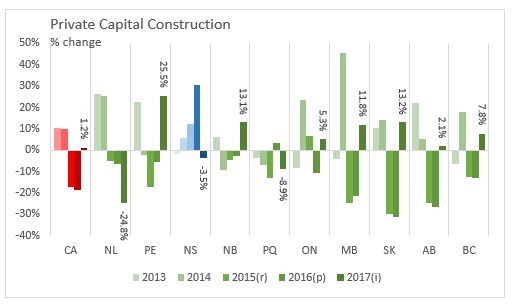
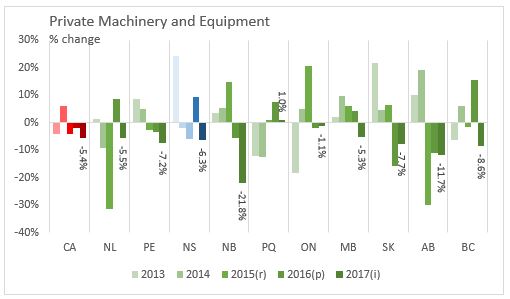

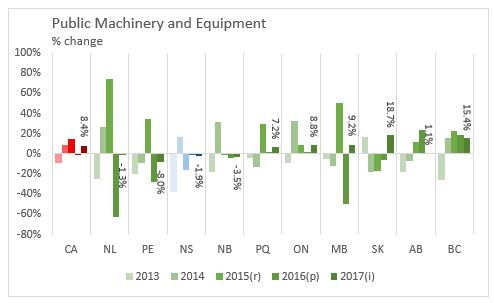
Capital and Repair Expenditures Survey, 2016 (preliminary) and 2017 (intentions)
<--- Return to Archive